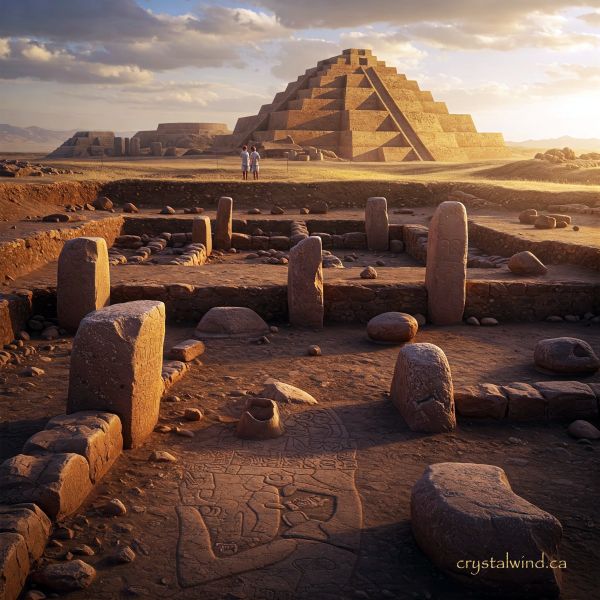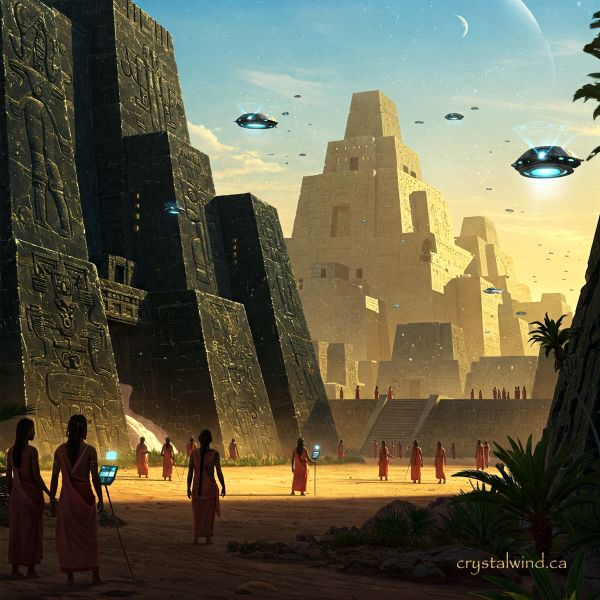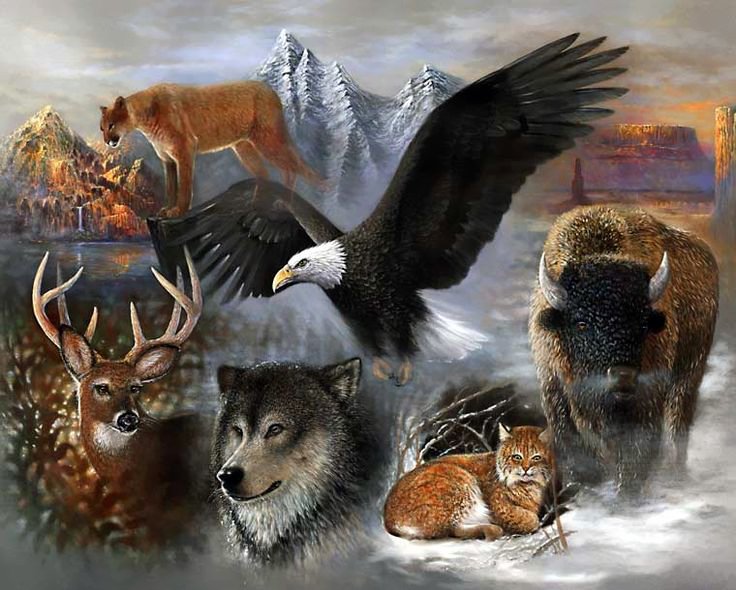Picture a world at the dawn of human history, over 10,000 years ago, where communities erected monumental structures, crafted intricate art, and possibly gazed at the stars with purpose.
Sites like Göbekli Tepe, Çatalhöyük, and Jericho challenge our view of early humans as mere hunter-gatherers. Could these be the fingerprints of advanced civilizations, lost to time? In this exploration, we dive into the archaeological evidence, mainstream theories, and tantalizing alternative perspectives to uncover whether sophisticated societies thrived millennia before recorded history.
A New Dawn: The World Over 10,000 Years Ago
Around 8000 BCE, the Earth was emerging from the Last Ice Age. Sea levels were rising, and human societies were transitioning from nomadic lifestyles to settled communities. This period, known as the Neolithic Revolution, saw the rise of agriculture and permanent settlements. But some archaeological discoveries suggest that certain groups may have achieved remarkable feats of engineering, art, and organization far earlier than expected. Let’s explore six key sites and cultures that hint at complex societies from this ancient era.
Göbekli Tepe: The First Temple or Something More?
In southeastern Turkey, Göbekli Tepe stands as one of the oldest known monumental structures, dated to 9600–7000 BCE. Its T-shaped limestone pillars, some 20 feet tall and weighing up to 20 tons, are arranged in circles, decorated with carvings of animals, humans, and abstract symbols.
- Why it’s remarkable: The site’s scale and craftsmanship suggest a highly organized society, predating the invention of writing or the wheel.
- Mainstream view: Archaeologists see it as a ceremonial center, possibly a temple, built by hunter-gatherers with emerging social hierarchies.
- Alternative theories: Some researchers propose Göbekli Tepe’s pillars align with constellations like Sirius, hinting at advanced astronomical knowledge. Could it be a remnant of a civilization with sophisticated intellectual traditions?
Curiously, the site was intentionally buried around 8000 BCE, raising questions about why such a masterpiece was hidden. Was it to protect sacred knowledge or to erase a civilization’s legacy?
Çatalhöyük: A Proto-City in Anatolia
Also in Turkey, Çatalhöyük (circa 7500–6400 BCE) is one of the earliest known urban settlements. This sprawling site housed up to 10,000 people in mud-brick houses packed tightly together, with rooftop entrances and vibrant wall paintings depicting hunting scenes and geometric patterns.
- Why it’s remarkable: Çatalhöyük’s size, art, and evidence of early agriculture suggest a complex society with cultural and economic systems.
- Mainstream view: It’s considered a pioneering Neolithic settlement, with inhabitants transitioning to farming and developing social structures.
- Alternative theories: Some speculate that Çatalhöyük’s intricate artwork and burial practices point to a spiritual or intellectual sophistication rivaling later civilizations.
The absence of clear social hierarchies in Çatalhöyük puzzles researchers. Could this egalitarian society have possessed advanced knowledge without centralized power?
Jericho: The Ancient Walled City
In the West Bank, Jericho’s archaeological layers date back to 9600 BCE, making it one of the oldest continuously inhabited sites. Its most famous feature is a massive stone tower, 8.5 meters tall, built around 8000 BCE, surrounded by a defensive wall.
- Why it’s remarkable: The tower and wall suggest advanced engineering and a need for defense or communal organization, unusual for such an early period.
- Mainstream view: Jericho was a thriving Neolithic settlement, with the tower possibly serving ceremonial or defensive purposes.
- Alternative theories: Some propose the tower’s alignment with solstices indicates astronomical knowledge, suggesting a culture with deeper scientific insights.
Why would a small community invest in such monumental architecture? Was Jericho a hub of a broader, advanced network?
Nevali Çori: Göbekli Tepe’s Predecessor?
Near Göbekli Tepe, the site of Nevali Çori (circa 8400–8000 BCE) in Turkey features similar T-shaped pillars and a temple-like structure, suggesting a regional cultural tradition. Excavated before being submerged by a dam, it revealed sculptures and evidence of communal gatherings.
- Why it’s remarkable: Its similarities to Göbekli Tepe suggest a shared cultural or technological framework across multiple sites.
- Mainstream view: Nevali Çori reflects early Neolithic religious practices, with communities collaborating on large-scale projects.
- Alternative theories: Could it be part of a network of advanced societies, sharing knowledge across Anatolia?
The loss of Nevali Çori to flooding leaves many questions unanswered, but its parallels with Göbekli Tepe fuel speculation about a forgotten civilization.
Puma Punku: An Andean Enigma
In Bolivia, Puma Punku (part of the Tiwanaku complex) is renowned for its precisely cut stones, some weighing over 100 tons, with laser-like edges and drilled holes. While mainstream dating places it around 500–600 CE, some alternative theories argue it could be far older, possibly predating 8000 BCE.
- Why it’s remarkable: The stonework’s precision seems to defy the technological capabilities of its attributed period.
- Mainstream view: The Tiwanaku culture used bronze tools and skilled craftsmanship to create these structures.
- Alternative theories: Fringe researchers suggest Puma Punku’s builders had access to advanced tools or knowledge, possibly from a pre-Ice Age civilization.
The debate over Puma Punku’s age and construction methods keeps it at the heart of discussions about lost technologies.
Mehrgarh: The Indus Valley’s Ancient Roots
In modern-day Pakistan, Mehrgarh (circa 7000–5500 BCE, with earlier layers possibly reaching 8000 BCE) marks the early stages of the Indus Valley civilization. This site features mud-brick structures, sophisticated pottery, and evidence of dentistry and agriculture.
- Why it’s remarkable: Mehrgarh’s early advancements in farming and crafts suggest a rapid leap toward complex society.
- Mainstream view: It’s a precursor to the Indus Valley’s urban centers, showcasing gradual cultural evolution.
- Alternative theories: Some argue Mehrgarh’s early sophistication hints at inherited knowledge from an older, advanced culture.
Could Mehrgarh be a bridge between a lost civilization and the later Indus Valley achievements?

Defining “Advanced”: What Makes a Civilization Sophisticated?
The term “advanced civilization” often evokes images of modern technology, but for ancient societies, advancement might mean different things: monumental architecture, astronomical knowledge, social organization, or specialized crafts. These sites demonstrate:
- Engineering Prowess: From Göbekli Tepe’s massive pillars to Jericho’s tower, early humans mastered large-scale construction.
- Cultural Complexity: Çatalhöyük’s art and Mehrgarh’s dentistry reveal rich intellectual and practical traditions.
- Astronomical Insights: Alignments at Göbekli Tepe and Jericho suggest an understanding of celestial patterns.
Mainstream archaeology attributes these achievements to human ingenuity, arguing that early societies developed these skills organically. However, alternative theorists propose that such sophistication could stem from a forgotten civilization, possibly predating the Ice Age, whose knowledge was passed down through oral traditions or lost artifacts.
The Evidence: What We Know and What We Don’t
Archaeological evidence supports the existence of complex societies over 10,000 years ago, but the “advanced civilization” hypothesis remains contentious. Here’s a balanced look:
Mainstream Perspective
- Göbekli Tepe and Nevali Çori: Built by hunter-gatherers with emerging social structures, using stone tools and communal labor.
- Çatalhöyük and Jericho: Early farming communities with innovative but not “advanced” technologies.
- Puma Punku: Achievable with known tools, despite its precision.
- Mehrgarh: A natural step toward later urban civilizations.
Alternative Perspective
- Astronomical Alignments: Sites like Göbekli Tepe and Jericho may encode celestial knowledge, suggesting a deeper scientific tradition.
- Precision Engineering: Puma Punku’s stonework and Çatalhöyük’s art hint at techniques beyond simple tools.
- Mythological Clues: Global myths, like Atlantis or the Indian Vimanas, might preserve memories of advanced pre-Ice Age cultures.
The lack of written records or advanced tools limits definitive conclusions, but the absence of evidence isn’t evidence of absence. Rising sea levels post-Ice Age may have submerged coastal settlements, hiding potential clues.
Why the Mystery Endures
The fascination with ancient civilizations stems from their ability to challenge our assumptions. These sites, built with precision and purpose, raise profound questions:
- Lost Knowledge: Were construction techniques or astronomical insights forgotten over time?
- Underestimated Ancestors: Are we underestimating the capabilities of early humans?
- Hidden History: Could cataclysmic events, like floods or comet impacts, have erased advanced societies?
The interplay of hard evidence and speculative wonder keeps the debate alive, inviting us to reimagine our past.
Conclusion: Echoes of a Forgotten Era?
From the enigmatic pillars of Göbekli Tepe to the proto-urban sprawl of Çatalhöyük, these ancient sites reveal a world far more complex than we once believed. Whether they were built by advanced civilizations or remarkably skilled early humans, they stand as monuments to our ancestors’ ingenuity. The truth may lie in a synthesis: societies that were advanced for their time, wielding knowledge we’re only beginning to rediscover.
What do you believe? Are these sites relics of lost civilizations, or testaments to human potential? Share your thoughts in the comments, and explore more ancient mysteries in our Power Places section.















































